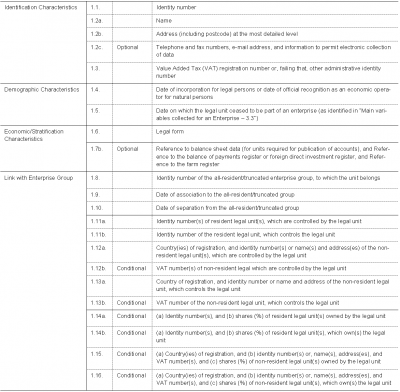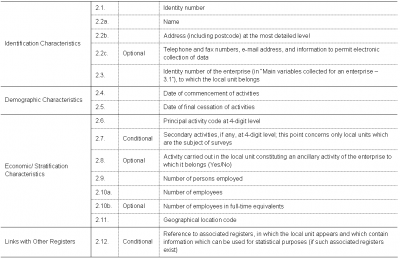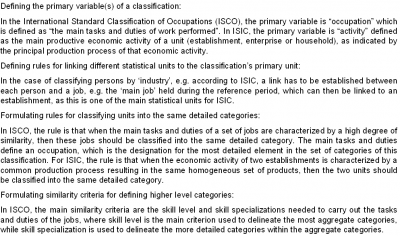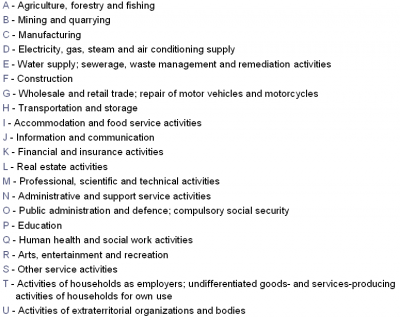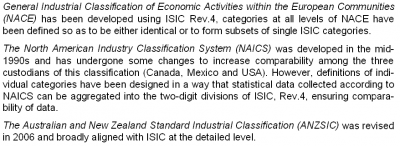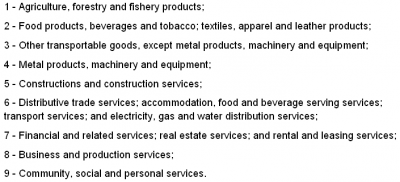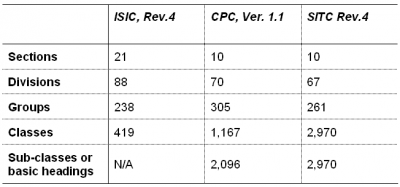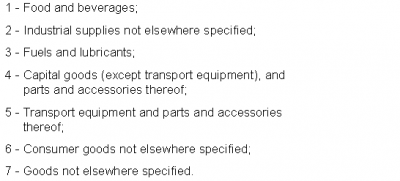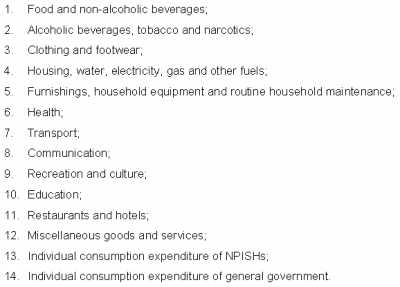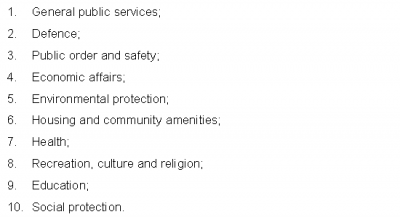Building the System of National Accounts - business register and statistical classifications
This article is part of a set of background articles explaining in some detail how statistics producers, such as national or international statistical institutes, may build a coherent system of national accounts (SNA), especially in developing countries. The articles are based on the official Eurostat handbook Essential SNA - Building the basics and they focus particularly on the early stages of the implementation.
The aim of this article is to highlight the fact that the status and quality of the statistical infrastructure make a decisive contribution to the compilation and quality of national accounts. Two of the main pillars of statistical infrastructure are identified and described in separate sections: the statistical business register (SBR) and classifications. While a good quality statistical business register should offer a realistic view of a country’s businesses, the classifications implemented by countries should envisage comparability in space and time.
The other two main components of statistical infrastructure, statistical data sources and administrative data sources have their own articles.
Full article
Business register
The statistical business register (SBR) plays an essential role in the construction and maintenance of an integrated economic information system, serving multiple purposes. One of these objectives is to provide quality data needed for the compilation of national accounts indicators. In other words, it is a list of businesses which includes those engaged in the production of goods and services.
For statistical purposes the business register is a tool used for preparing and coordinating surveys as well as an information source used in the statistical analysis of the business population and its demography. It is also used for administrative data as well as for identifying and constructing statistical units.
The register comprises:
- all enterprises carrying on economic activities contributing to the gross domestic product (GDP) and their local units;
- the legal units of which those enterprises consist;
- truncated enterprise groups and multinational enterprise groups;
- all resident enterprise groups.
Objective
The SBR exists primarily for the purpose of supplying a framework for all economic surveys. Therefore it is designed to provide a means of coordinating the coverage of business surveys and of achieving consistency in classifying statistical reporting units. It also serves as a data source for compiling demographic information about businesses.
Variables
The typical units in an SBR are legal units and local units, whereas for statistical purposes, these must be transformed into units such as enterprises and establishments.
Legal units include:
- legal persons whose existence is recognised by law irrespective of the individuals or institutions which may own them or are members of them;
- natural persons engaged in an economic activity in their own right.
A legal unit always forms, either by itself or sometimes in combination with other legal units, the legal basis for a statistical unit known as the ‘enterprise’.
A local unit is an enterprise or part thereof (e. g. a workshop, factory, warehouse, office, mine or depot) situated in a geographically identified place. At or from this place, an economic activity is carried out for which - save for certain exceptions - one or more persons work (even if only part-time) for one and the same enterprise.
In the first section, Basic concepts, of the article, Building the System of National Accounts - basic concepts, the relationships between enterprises, local units and establishments are outlined.
The units listed in a register should be described according to type of statistical unit (legal unit, local unit and enterprise) using three categories of variables:
- Identification variables (identity number, name of enterprise, name of the owner, address, legal status);
- Stratification variables (economic activity, number of employees, sales turnover, geographical location);
- Demographic variables (births, date of changes in economic activity, deaths).
It is important to ensure the utmost accuracy of data, particularly those used as stratification variables in the sampling process (for example, variables relating to size and activity classification), together with identification data thus enabling contact with firms. The main variables included in an SBR are presented in Figures 1, 2 and 3.
The use of standardised statistical units in an SBR guarantees time-consistency in surveys, avoids duplications and omissions in data collection and improves the final quality of results by allowing greater coordination between surveys. The existence of a unique identification number, usually a legal code attributed by the tax administration, can greatly enhance the capacity for coordination between the various sources, including administrative ones.
Implementing and developing an SBR
The starting point for the construction of an SBR is invariably the use of administrative records showing the enterprises created and maintained for supporting administrative regulations. In order to answer statistical needs, information from administrative registers is adapted and included in an SBR.
The main issue in managing an SBR is its maintenance and update, given the pace of change in the business world. Registers must be updated at least once a year.
The most effective method of updating an SBR combines using information from administrative sources[1], business surveys and register maintenance surveys.
- Administrative sources have the advantage of covering the entire enterprise universe. It is essential for statistical and administrative bodies to employ a standardised activity classification system. Failure to do so may seriously compromise the final quality of the results of surveys based on a register. The use of conversion tables to adapt the data to the classification employed by the statistical body is not recommended, because this process results in major quality losses, since it is common to find situations where the transfer is not direct or one-to-one. To avoid this problem, statistical offices should attempt to persuade the bodies that produce the main administrative records to use a single activity classification table.
- Surveys offer more complete information, albeit for a more restricted population.
- Register maintenance surveys are specifically undertaken to update an SBR. Some statistical agencies undertake the survey in cooperation with the primary registration authority. For small enterprises, including informal sector operators, register maintenance surveys are crucial.
Questions for practitioners
An important issue relating to the construction of statistics and the national accounts system of a country is the existence and the quality of its business register.
The main issues concerning business registers relevant for statistics and national accounts are:
- Does an SBR exist in the statistical office or does it need to be constructed? What other administrative records and registers exist in the country?
- If an SBR exists, how good is the quality of its information? Is it based on the most suitable administrative sources? Is it updated regularly? In countries where administrative records are insufficient or unavailable for frequently feeding and updating their business registers, an economic census becomes a crucial tool for providing information about active enterprises and establishments required for compiling national accounts.
- To what extent does the quality of an SBR affect the quality of statistical surveys used for compiling national accounts?
- Is the classification of industries used in an SBR in line with SNA requirements?
- Is the SBR used as a sample for statistical surveys?
Classifications
Classifications are a key element in the compilation of statistical indicators. The SNA uses several classifications; some of them are specific to the compiling of national accounts, such as classifying units into institutional sectors, goods and services, or transactions. Others are common to national accounts and other statistical domains.
The premise used for compiling national accounts is that data sources should be adapted and collected in accordance with international classifications.
The implementation of a classification and the main classifications used in SNA are presented below.
Importance of adopting international classifications
Classifications organise units such as persons, enterprises, activities, etc. into groups according to a standard format defined according to the principles and criteria that have been used to construct them.
A standard statistical classification (SSC) is a set of discrete categories that may be assigned to a specific variable registered in a statistical survey or in an administrative file, and used in the production or presentation of statistics. National statistical authorities are responsible for the implementation, development, use and updating and/or revision of the national standard statistical classifications (NSSCs).
International standard statistical classifications (ISSCs) are developed and adopted by international institutions to ensure correct implementation of international agreements and to standardise national and international communication, promoting comparability of international statistics. ISSCs are products of agreements between national authorities responsible for statistics in the respective areas, and may serve as models for developing corresponding national, multinational and regional statistical instruments.
One of the advantages of ISSCs is that they can be adopted as national classifications by countries that do not have the experience or resources to develop them; in addition they can be used as a guide for adapting national classifications to international standards.
Implementing a classification
Four types of methodological issues must be considered when adapting ISSCs for national use: issues relating to the identification of user requirements; issues relating to the conceptual basis for the SSCs and their structure; issues relating to the collection of the information required for developing the classification and maintenance and update of classifications.
- User requirements: It should be determined who the users are, how they will use the classification and the statistics produced with its help, to accommodate the adaptation of ISSCs to national needs.
- Conceptual tasks: Primary statistical units[2] should be identified, as well as the possible ISSC categories to be assigned to them. How statistical units are linked to the classification’s primary unit needs to be determined. The structure of the classification needs to be defined in order to arrange content in such way that the aggregations of the most detailed categories in the set are based upon similar criteria and which will be meaningful for descriptive and analytic comparisons. Rules should be drawn up to identify when statistical units should be classified into the same most detailed classification category, and when they should be classified differently. Similarity criteria are required to define higher-level categories (aggregated groups of categories) in hierarchical classifications[3].
- Collecting and presenting information: in order to develop a classification, information needs to be collected and explanatory notes prepared which explain the boundaries between each of the classification categories using definitional descriptions and/or listing what is included or excluded. It is also important to present correspondence tables which enable systematic comparisons between classifications to be made and which present a classification structure map, listing levels, codes, hierarchies, etc. Correspondence tables indicate how, where and to what extent, concepts and categories in one classification may be found in other classifications, or in earlier versions of the same classification.
- Maintenance of a classification includes the activities undertaken to ensure classification errors, or ones in the explanatory notes or associated coding tools are corrected. Updating is an important process for presenting all the news in the field, for modifying descriptive category definitions, as well as introducing new categories into the existing structure and new coding tools.
Main classifications
(a) International standard industrial classification of all economic activities Revision 4 (ISIC, Rev.4) is the international reference classification for productive activities. It groups activities according to homogeneous production technologies for a range of products.
The scope of ISIC is to provide a set of activity categories that can be utilised for the collection and reporting of statistics according to such activities. It provides a comprehensive framework within which economic data can be collected and reported in a format that is designed for purposes of economic analysis, decision-taking and policy-making. ISIC Rev.4 aims to present a set of activity categories in such a way that entities can be classified according to the economic activity they carry out. ISIC Rev.4 is a classification according to kind of economic activity.
The main uses of ISIC are:
- In the field of national accounts, the ISIC classification is used to develop the production account and the generation of income accounts by industry. In this sense, the following main aggregates are compiled by industry: output, intermediate consumption, value added, compensation of employees, gross operating surplus. The supply and uses tables are based on ISIC, providing the value of different products produced by and consumed in different industries.
- ISIC provides the basis for the construction of the survey framework, namely the Statistical business register. An SBR contains information on the enterprises detailed in different classifications: the one used for the main activity being ISIC.
- The observation and collection of selling prices for industrial products used to calculate the industrial production price index (IPPI) are carried out on a representative sample of economic operators for each ISIC activity class.
- ISIC is the basis for addressing the reports and surveys of enterprises related to their activity performance, thus obtaining indicators (intermediate inputs, compensation of employees, fixed assets, etc.) by industry. Structural surveys cover enterprises from almost all ISIC classes. The turnover/value and volume indices of turnover are obtained from ISIC. Specific industry surveys are based on samples from the business register, enterprises involved in the same activity formed by grouping ISIC classes.
- Many social indicators relate to ISIC classification, being compiled by industry indicators such as: number of employees, gross/net average salary, labour force cost indices, etc.
(b) Central product classification Version 2 (CPC Ver.2) is a classification based on the physical characteristics of goods or on the nature of services rendered. It includes products that are an output of an economic activity, including transportable goods, non-transportable goods and services. CPC presents categories for all products that can be the object of domestic or international transactions or that can be stocked.
CPC Ver. 2, finalised in 2008, was imposed by the revision of the Harmonized system (HS) in 2007, by the fourth revision of ISIC and by the changes in the world economy.
The main purpose of the CPC is to provide a framework for comparing international product statistics and to serve as a guide for developing or revising existing product classification schemes to make them compatible with international standards.
The main uses of CPC are:
- the SNA uses the CPC to balance the supply and uses tables. In this sense, all main component aggregates are balanced by product;
- the CPC is used as an instrument for assembling and tabulating all kinds of statistics requiring product detail;
- for the calculation of industrial production indices, quantitative data regarding achieved production of goods are registered using the CPC;
- the industrial production price index is based on selling prices for industrial products identified by CPC, for selected industries classified using ISIC.
(c) Standard international trade classification (SITC Rev.4) classifies commodities into different categories according to the nature of the merchandise and the materials used in their production as well as according to their stage of production, in turn suitable for economic analysis. The origin of SITC is the Harmonized Commodity Description and Coding System (HS07). SITC is the aggregated classification of transportable goods both for international trade statistics and for analytical purposes.
The scope of SITC is to cover all goods classifiable in HS except for monetary gold, gold coin and current coin. All basic headings in SITC Rev.4, (except for 911.0 - Postal packages not classified according to kind and 931.0 - Special transactions and commodities not classified according to kind) are defined in terms of HS07 subheadings.
The SITC is used:
- In SNA, as a classification of imports and exports. This classification identifies details of commodities for a variety of purposes, including customs, statistical and analytical purposes, particularly for the presentation of external trade statistics with detailed commodity specifications.
- To present and disseminate the huge amount of data in respect of import and export of goods.
These three classifications (ISIC, CPC and SITC) are closely interrelated. ISIC represents the activity side of the system, CPC is the central instrument for classifying goods and services and SITC is, for analytical purposes, the aggregated classification of goods for international trade statistics. Both CPC and SITC use the headings and subheadings of the HS as building blocks for their categories. Subsequently, relationships with other classifications that may require a degree of comparability with ISIC have been added to these considerations. By rearranging the CPC categories according to their industrial origin and using the link between CPC, SITC and HS, a detailed correspondence table between SITC, CPC and ISIC has been established.
(d) The Classification by broad economic categories (BEC) Rev.3 was initially developed by UNSD for internal purposes in order to reclassify merchandise imports (reported in terms of SITC) into the product categories relevant to the SNA. Over time, many countries have started to use BEC for a variety of purposes including economic analysis and setting tariffs. In addition, it was designed to serve as a means of converting external trade data compiled using SITC into end-use categories that are meaningful within the framework of the SNA, namely categories approximating the three basic classes of goods in the SNA (capital goods, intermediate goods and consumption goods). Specifically, the subcategories of the BEC can be aggregated to approximate these three classes of goods. This aggregation enables external trade statistics to be considered jointly with other sets of general economic statistics, such as national accounts and industrial statistics, for national, regional or world-wide economic analysis. The BEC consists, at level 1, of 7 main categories identified by one-digit numerical codes, at level 2, of 14 categories identified by two-digit numerical codes, at level 3, of 8 sub-categories identified by three-digit numerical codes.
(e) Classifications of expenditure according to purpose
The SNA uses special classifications to analyse consumption, or more generally outlays, by different sectors depending on the purpose for which the expenditure is undertaken. Such classifications are referred to as functional classifications or as Classifications of expenditure according to purpose. They are:
- Classification of individual consumption according to purpose (COICOP) includes categories such as: food, health, education services, etc. COICOP has 14 main categories, the first 12 refer to individual consumption expenditure of households and the last two identify those parts of consumption expenditure by non-profit institutions serving households (NPISHs) and general government that are treated as social transfers in kind.
Once the consumption expenditures of NPISHs and general government have been classified according to COPNI and COFOG (see below), individual consumption expenditures in these two classifications can be transferred directly into Divisions 13 and 14 of COICOP. In COICOP, classes are divided into services, non-durables, semi-durables and durables.
- The Classification of the functions of government (COFOG) is consistent with that proposed in the Government finance statistics manual 2001 (GFSM 2001), e.g.: government expenditure. The units of classification are, in principle, individual transactions. This means that a COFOG code should be assigned to each purchase, wage payment, transfer, loan disbursement or other outlay according to the function the transaction serves. A major use of COFOG is to identify consumption expenditures that benefit individual households and which are transferred to Division 14 of COICOP to derive the 2008 SNA aggregate of actual final consumption of households. COFOG is also used to distinguish between individual and collective services provided by general government. Expenditures on individual services are treated as social transfers in kind. They are deducted from total final government consumption expenditure to obtain actual final government consumption and added to the final consumption expenditures of households and NPISHs to obtain actual final consumption of households.
- Classification of the purposes of non-profit institutions, serving households (COPNI) classifies individual outlays of NPISHs according to the purpose they serve. These outlays could be from health, education services, religious associations, etc. The same outlays as for COFOG can, in principle, be classified according to COPNI. The main emphasis should be on the classification of final consumption expenditure since this is to be transferred to COICOP Division 13 to obtain actual final consumption of households. NPISHs produce goods and services, but typically services, which are provided to individual households, so the consumption expenditures are treated as individual consumption.
- Classification of the outlays of producers, according to purpose (COPP) applies to all producers, whether market or non-market, although in practice, market transactions are the most interesting. COPP may provide information on ‘outsourcing’ business services, that is, on the extent to which producers buy catering, cleaning, transport, auditing and other services that were previously carried out as ancillary activities within the enterprise. It has to be borne in mind that this classification is mainly used to classify production cost, capital formation and other production-related data that are identified by establishments. The COPP categories can be easily identified with ISIC, and CPC categories.
Questions for practitioners
Within a business register, classifications represent the essential elements for building the statistical system, including national accounts. As part of the central framework of the national accounts compilation strategy, the main classifications used in the statistical system are adopted and/or developed according to the answers to the following questions addressed in a systematic way:
- Are international classifications implemented in the statistical system and are they used for the collection, compilation and dissemination of statistical data sources?
- What are the classifications used in the administrative system? Are they in line with the statistical classifications and can they be used for national accounts purposes?
- Are there correspondence tables between the different classifications to ensure system consistency?
If these issues are respected then this will contribute significantly to ensuring compatibility and comparability of statistics and national accounts indicators.
Direct access to
- Building the System of National Accounts (online publication, overview of all articles)
- Regulation 177/2008 of 20 February 2008 on establishing a common framework for business registers for statistical purposes and repealing Council Regulation (EEC) No 2186/93
- Summaries of EU legislation: Business registers for statistical purposes
- Afristat - Guide methodologique pour l’elaboration des comptes nationaux dans les états membres d’Afristat, Serie Méthodes No.4, 2001
- Fritz B., MPRA - Uses of National Accounts; History, International Standardization and Applications in the Netherlands, Eagle Economic & Statistics, Working paper 2008-1; Chapter II: The early estimates (1660-1930); Chapter III: Revolutionary decades (1930-1950); Chapter IV: The era of the international guidelines (1950-)
- IMF
- Government Finance Statistics Manual 2001 (GFSM2001), 1998
- Harmonized Commodity Description and Coding System (HS07)
- OECD
- Policy Uses of National Accounts: An OECD Perspective, paper presented to the joint ECE/Eurostat/OECD Meeting on national accounts, 2002
- Understanding National Accounts, Lequiller F., Blades D., OECD 2006
- Sturm, R. - A motivational model for running a statistical business register, Paper presented to the European Establishment Statistics Workshop – EESW09, Stockholm, 2009.
- United Nations
- 2008 SNA, European Commission, IMF, OECD, UN, World Bank, 2009; Chapter I: Introduction; annex 3: Changes from the 1993 System of National Accounts
- National Accounts: A practical introduction, Studies in Methods, Series F, No.85, UN 2003; Chapter VIII: SNA framework for the total economy
- A Systems Approach to National Accounts Compilation, Studies in Methods, Series F, No.77, UN 1999; Introduction
- Use of Macro Accounts in Policy Analysis, Studies in Methods, Series F, No.81, UN 2002; Chapter II: The role of macroeconomic and social accounting in policy analysis; Chapter III: Uses of National Accounts in economic analysis
- International Standard Industrial Classification of All Economic Activities - Revision 4, Statistical papers, Series M No. 4/Rev.4, UN 2008
- Central Product Classification (CPC) – Version 2, UN 2008
- Standard International Trade Classification - Revision 4, Statistical papers, Series M No. 34/Rev. 4. UN 2006
- International merchandise trade statistics: Concepts and definitions, Studies in Methods, Series M, No.52, Rev.2, 1998
- Classifications of Expenditure According to Purpose: Classification of the Functions of Government (CO-FOG) - Classification of Individual Consumption - According to Purpose (COICOP) - Classification of the Purposes of Non-Profit Institutions - Serving Households (COPNI) - Classification of the Outlays of Producers - According to Purpose (COPP), Statistical paper, Series M, No.84., UN 2000
- Statistical business registers based on administrative records , paper presented to the Second meeting of the Statistical Conference of the Americas of the Economic Commission for Latin America and Caribbean, June 2003; Chapter II: ‘Objectives and uses of the statistical business register’
- Statistical Business Register in countries of Eastern Europe, Caucasus and Central Asia: 2008 Questionnaire Survey results, paper presented to the Conference of European Statisticians, 2009
Notes
- ↑ Authorities responsible for the primary registration of private sector businesses, tax offices, social security offices, government departments for information about public sector establishments (schools, hospitals, public utilities etc.), organisations of professionals (physicians, lawyers, etc.) and the ministry of agriculture for agricultural establishments.
- ↑ The observable units that can be assigned to one unique category of the classification without reference to any other observable unit.
- ↑ A tree-like structure consists of different levels into which a response can be classified depending on its detail. The most detailed level is always the lowest level of the classification.
